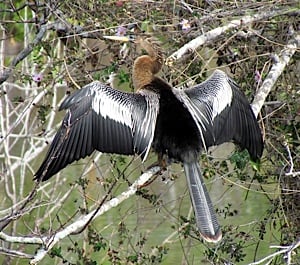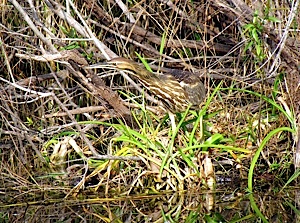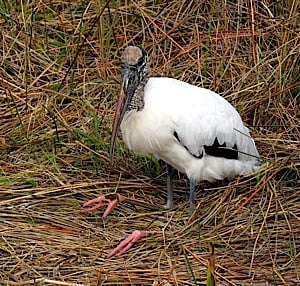I don’t often seek out the most-visited areas of national parks. Artist’s Point at Yellowstone National Park should probably be required viewing for every American, but please don’t take me there on a Saturday in summer!
Thus it came as a shock to my companions when I insisted during my first excursion to Everglades National Park that I wanted to head straight to the Anhinga Trail. Less than a mile long, this trail is a combination of pavement and boardwalk, fully handicapped accessible, and one of the most crowded areas of the whole park. For once, I didn’t care about the crush of humanity. Birds were on my mind.
The Everglades are a unique ecosystem to North America. It’s a vast sub-tropical wetland the likes of which cannot be found anywhere else on the continent. If you want to see virtually all of our wading birds in one place at one time, you go to Florida. The Atlantic coast’s Merrit Island National Wildlife Refuge draws lots of birders, as does Ding Darling National Wildlife Refuge on Sanibel Island.
But the Everglades offer the most accessible and user-friendly experience, especially if you’re joined by non-birders, young children, or folks that have trouble getting around.
As you approach the parking lot at the Royal Palm area of Everglades National Park the vultures watch you intently. Seeing all of the black vultures (Coragyps atratus) glaring at me was bit disconcerting until I remembered that they were likely not waiting for me to die, but simply to park the car.
They wanted the windshield wipers.
Yes, the vultures are known to cause considerable damage by devouring the exposed rubber parts of cars. I have yet to receive a good explanation for why they do this when there are plenty of animal carcasses and other good food around, but we still hopped out of the car and immediately wrapped the wiper blades in plastic bags, which for some reason deters the birds. I was determined to not have to go back to the rental counter and tell them the wiper blades on their brand new Prius had been consumed by vultures. Minutes later we were on the trail and I couldn’t help but notice the vultures taking some long looks at my friend Dave’s hiking boots.

The anhinga needs to roost to dry its feathers. Photo by Kirby Adams.
You’d expect a few things from a trail called the Anhinga Trail. One is surely that you will see plenty of anhinga (Anhinga anhinga), one of the oddest of our native water birds. The anhinga is the only member of the darter family found in the new world. The darters are collectively called “snake birds” because of their long serpent-like necks that are often the only part of the bird sticking out of the water as they swim past.
Bearing a superficial resemblance to the more well-known cormorants, anhinga are a joy to watch in clear water as they dive for fish and sometimes decide to just start walking, fully submerged, across the muddy bottom.
As the trail turns into a boardwalk that winds through the slough, small anhinga rookeries begin to appear everywhere. We’re visiting in the first week of January when nest-building is just beginning in earnest.
Like cormorants, anhinga lack the oily waterproofing of the feathers most water birds enjoy. After a dive or stroll in the water, they must sit with wings spread in the sun to dry off before going about further business. This gives us a great chance to see the elegant shape and plumage of these birds that may appear relatively ugly at first glance. Dave comments that if he was to set one on fire, it would look exactly like most renderings of the mythical Phoenix.
Despite our earlier tension with the vultures, we won’t be setting any birds aflame, although Dave’s astute observation makes me wonder if a darter posed against a setting sun was somehow inspirational for the story of the Phoenix.
Eight of the 12 members of the heron family commonly found in the United States make an appearance for us. Great Blue Herons (Ardea Herodias) and Great Egrets (Ardea alba) are common back home in Michigan, but here the snowy egrets (Egretta thula), little blue herons (Egretta caerulea), and tricolored herons (also called Louisiana herons, Egretta tricolor) are a dime a dozen.
It seems we can’t look anywhere without having three or more heron species in view.

The camouflaging of its feathers make the American bittern difficult to spot. Photo by Kirby Adams.
The highlight from this family is the emergence of an American bittern (Botaurus lentiginosus) from the reeds. Bittern are spectacularly well-camouflaged for life in the grasses and equally skilled at remaining still and posed perfectly to resemble the vegetation. While not particularly uncommon, it’s a treat to see one in the open hunting for fish.
Joining the herons is another large wading bird, the endangered wood stork (Mycteria americana).
These guys are ugly. Many ornithologists today place the storks as close relatives of the wiper-raiding vultures, and that isn’t much of a stretch if you look at their featherless, wrinkly heads.
Wood Storks are endangered only in terms of the breeding population in the southeastern U.S. They are common over much of their range in Central America, tropical South America, and the Caribbean. Efforts to preserve nesting populations have been somewhat successful, but while you might find some wood storks as far north as South Carolina, it’s far more difficult than in the Everglades where they tend to be easy to locate.
Our day-list of birds was rounded out by moorhens, purple gallinules, coots, grebes, and ducks. The notable missing water bird was the Canada goose (Branta canadensis), such a fixture everywhere else in the country, but absent from southern Florida. Having spent my fair share of time dodging goose droppings everywhere I look for water birds, I can’t say this absence bothered me much.

Ungainly and ugly to some is the wood stork. Photo by Kirby Adams.
The only other animals of note spotted this beautiful morning were lots of people and lots of alligators. The alligators generally appear disinterested in their surroundings, and having arrived early in the morning, there weren’t too many people milling about until we were returning to the visitor center.
I did stop to observe one particular exchange just before leaving for the day. A little girl of about 7 or 8 years was scanning the reeds with binoculars that seemed gigantic and almost too heavy for her to hold steady. She stopped and focused on something and asked her father if she was seeing a little blue heron.
Her dad checked the bird for himself and then told his daughter she’d found a tri-colored heron, explaining the lighter belly as a field mark that distinguishes it from the little blue. The girl lowered her binoculars and with a big grin repeated to her herself, “tri-colored heron.” I left the trail thinking that thanks to Everglades National Park, the Anhinga Trail, and one young father in particular, the world might be OK after all.
Getting to Anhinga Trail: The Royal Palm area is only 4 miles from the Ernest F. Coe visitor center at the east entrance to the park, about 50 miles from Miami International Airport. There is a visitor center with restrooms and substantial parking area at Royal Palm.
More of my photos from the Anhinga Trail can be found here at my flickr page.


 Support Essential Coverage of Essential Places
Support Essential Coverage of Essential Places






